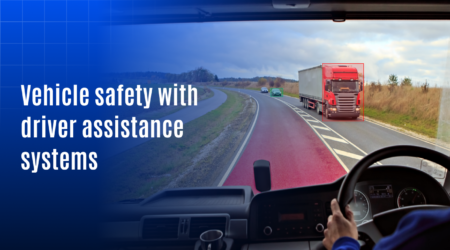The Impact of Driver Monitoring Systems on Road Safety and Insurance in the USA

Road safety continues to be a critical challenge for commercial fleets across the United States. According to the National Highway Traffic Safety Administration (NHTSA), over 40,000 road fatalities were reported in 2023, with a significant portion linked to distracted or fatigued driving. Notably, 94% of vehicle crashes in the U.S. are caused by human error highlighting the urgent need for proactive driver behavior monitoring in fleet operations.
Fleet-based incidents don’t just risk lives they impact insurance premiums, operational efficiency, and business credibility. With insurance costs rising annually for commercial fleets, businesses are now turning toward Driver Monitoring Systems (DMS) as a strategic investment in both safety and savings.
In this blog, we explore how driver monitoring systems in USA are reshaping the fleet landscape by reducing risk, improving compliance, and enabling insurance advantages for transport businesses.
What Are Driver Monitoring Systems?
Driver Monitoring Systems are AI-powered solutions that use sensors and cameras to assess a driver’s condition in real time. These systems track:
- Eye and head movement to detect distraction
- Blinking patterns and facial expression to assess drowsiness
- Hand activity and posture for signs of inattentiveness
- In some cases, even heart rate or driver stress levels
These insights allow the system to trigger instant in-cabin alerts or notify the fleet manager when risky behavior is detected helping prevent accidents before they occur.
Key Challenges Faced by Fleets in the USA
1. High Accident Rates from Human Error
Even with GPS tracking and telematics in place, driver error still accounts for the majority of road incidents. Fatigue during long-haul trips or mobile phone usage during short-distance deliveries can result in severe losses.
2. Rising Insurance Premiums
U.S. commercial fleet insurance premiums have been increasing steadily due to higher claims. Fleets that lack visibility into driver behavior are often subjected to blanket premium hikes, regardless of performance.
3. Compliance and Legal Exposure
With increasing federal attention on transportation safety, non-compliance due to poor driver behavior could lead to lawsuits, penalties, or license revocation especially in cross-state or regulated cargo operations.
How Driver Monitoring Systems Solve These Challenges
1. Real-Time Alerts for Unsafe Driving
Driver monitoring systems deliver in-cabin notifications when the system detects drowsiness, distracted behavior, or prolonged eye closure. This helps drivers self-correct without external intervention.
2. Actionable Insights for Fleet Managers
Through the software dashboard, managers can view driver fatigue trends, risk scores, and incident logs. This enables:
- Targeted driver training
- Automated alerts to supervisors
- Performance-based coaching
3. Improved Insurance Negotiation
Insurance providers are now offering discounts to fleets using verified DMS data. These systems create driver profiles that support risk-based premium calculations helping companies cut costs by 10–25% depending on usage.
4. Reduced Liability and Better Claims Defense
In the event of an accident, DMS-generated reports and video logs can serve as legal evidence to demonstrate whether the driver was attentive. This minimizes false claims and supports faster settlements.
Business Value: Why Fleets Are Adopting Driver Monitoring in the USA
1. Accident Prevention = Cost Reduction
One logistics company in Florida integrated DMS across its mid-sized fleet and reported:
Within six months, they recouped the hardware and software investment through reduced damage claims and insurance savings.
2. Driver Accountability with Less Micromanagement
DMS acts as a neutral observer, improving driver accountability without constant human oversight. This enhances driver-manager trust and improves morale in the long run.
3. Future-Readiness for Compliance
Upcoming federal mandates such as those under the Infrastructure Investment and Jobs Act (IIJA) are likely to push for mandatory in-vehicle safety tech. Early adoption of DMS puts fleet operators ahead of future compliance demands.
The Insurance Angle: Shifting to Usage-Based Models
Insurance carriers in the U.S. are actively promoting Usage-Based Insurance (UBI) models. These models use data from DMS, telematics, and behavior scores to determine premiums.
According to industry reports, fleets using DMS-based data have observed up to 30% lower premiums, especially when combined with other safety solutions like ADAS and dashcams.
System integrators and fleet solution providers can use this trend to position DMS as a value-added feature in their offerings, helping clients unlock insurance benefits while improving operational safety.
U.S. Market Outlook: Rapid Growth Ahead
This growth is not limited to large fleets small and mid-sized fleets are also entering the space, thanks to aftermarket DMS solutions that are affordable and scalable.
How to Get Started: Recommendations for Fleet Operators
- Choose a DMS-integrated fleet software
Look for solutions that combine GPS tracking, driver behavior, video telematics, and DMS into one platform for centralized control. - Start with a pilot program
Test the impact on a small subset of your fleet track how incidents, insurance costs, and delivery efficiency improve over 2–3 months. - Train your drivers early
Before rollout, ensure drivers are aware of how the system works and how it helps them. Reinforce that it’s a safety tool not surveillance. - Leverage your data for insurance discussions
Share DMS data with insurers to negotiate custom premium terms based on your actual safety record.
Final Thoughts: A Safety Investment That Pays Off
Driver monitoring systems in USA are no longer limited to high-end OEM vehicles. They are fast becoming a fleet essential, thanks to their ability to reduce accidents, lower costs, and improve insurance outcomes. For fleet owners, logistics providers, and system integrators, DMS offers a practical and scalable way to meet safety goals while staying competitive.




